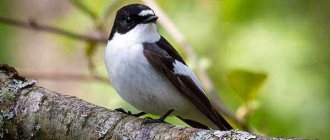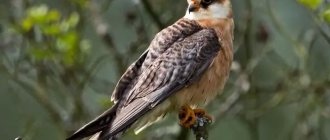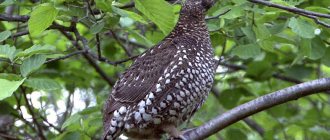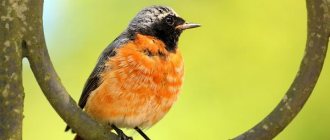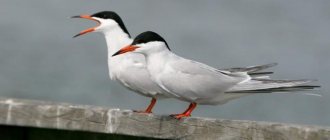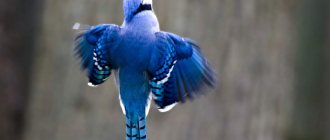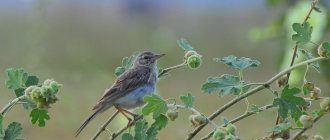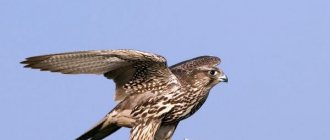| Latin name: | Aegithalos caudatus |
| English name: | To be confirmed |
| Kingdom: | Animals |
| Type: | Chordata |
| Class: | Birds |
| Squad: | Passeriformes |
| Family: | Long-tailed tits |
| Genus: | Long-tailed tits |
| Body length: | 6-7 cm |
| Wing length: | 6 cm |
| Wingspan: | 20 cm |
| Weight: | 10 g |
Description of the bird
The long-tailed tit received the popular name of the ladle tit due to the shape of its body, which looks like a fluffy ball with a long tail and resembles a pouring spoon of the same name. This species is the most common in the family of long-tailed tits and lives in Asia and Europe.
The singing long-tailed tit is very small, its weight barely reaches 10 g. The body length is only 6-7 cm, and the tail is disproportionately long - up to 10 cm in length, the wingspan is up to 20 cm. The feathers of the long-tailed tit are thick and fluffy and the plumage distinguished by its beauty. The color of the bird's head, neck and belly is white, the back and most of the wings are jet black, with pink and brown streaks. The tail and sides are soft pink. The wings are also decorated with white and pink feathers.
MASKED MASTERPIECES
In March, flocks begin important preparations for spring: pairs form. As a result, the groups gradually disintegrate. In April, pairs begin to build nests. This process takes quite a long time for the polovniks, up to two or even three weeks. And there is nothing surprising here: this is not a nest, but a real work of art. A large oblong ball is usually located in the fork of branches, at a height of 7-10 m. Thick, warm and reliable walls are woven from moss, pieces of birch bark and lichens and fastened with cobwebs; The inside is lined with down, feathers and wool. The entrance to the home is always from the side, and it is so skillfully camouflaged that it looks like an ordinary growth on a trunk.
Nutritional features of the ladle
— Advertising —
In search of food, the bird deftly moves through the trees
The baby moth eats mainly small insects, their eggs, and spiders. In search of food, the bird deftly moves along tree branches, while it raises its tail high and can hang upside down.
Aphids are the long-tailed tit's favorite treat. And the destruction of aphids by these little ones is very useful for forests.
In winter, the polovnik can add tree seeds and other plant food to its diet.
Natural enemies of the long-tailed tit
Photo: Bird polovnik
Long-tailed tits, like their larger relatives, are very useful birds for both forestry and agriculture, since their main food is small insects and their larvae, most of which are malicious pests that cause significant damage to field, garden and garden crops. forest crops.
One of the main natural factors that annually negatively affects the number of tits is winter hunger and severe frosts. It is from the cold and lack of food that a huge number of these birds die every year in the winter months - about a third of the population, and in some years even more. However, you should not be upset about this - things are not so bad. After all, every summer, with the onset of the breeding season, the damage brought to the population of tits in winter is reduced to nothing, since tits are incredibly fertile and each pair of birds can hatch up to 18 chicks.
Interesting fact: Long-tailed tits very zealously try to camouflage their nests, and for this they use not only natural materials: bark, moss, lichen, but also artificial ones, such as pieces of polyethylene and even plastic.
Also, in natural conditions, martens, weasels, wild cats, other felines, flying predators (owls, hawks, falcons) are successfully hunted by martens, weasels, wild cats, and in places close to human habitation - domestic cats and stray dogs. However, this factor cannot be called so decisive.
Bird species
The long-tailed tit species includes 23 subspecies. These birds were not identified as independent species, since the differences between them are very small and consist mainly in which zones of the general range a particular subspecies inhabits.
For example, the pink long-tailed tit differs from its relatives in the presence of black stripes on its head and is distributed in the west of the region, in France and Great Britain.
Pink polovnik on a branch in packra
The Pyrenean long-tailed tit lives in Italy, and on the back of adult individuals of this species there are no black feathers at all.
Pyrenean long-tailed tit sitting on a branch
The eastern subspecies are the Balkan and South Japanese long-tailed tits. The Balkan is the smallest representative of the species; the plumage on its back is gray.
Reproduction and lifespan
In March, important events in the lives of the polovniks occur - couples are formed among them. Throughout April they build nests that are a masterpiece. Both the male and the female incubate the eggs. It lasts about two weeks. After this time, small and completely defenseless chicks are born.
There can be about 15 of them in a nest. After another two weeks, the babies fledge and become like their parents. Now a young chick can be distinguished from an adult only by their grimy forehead and cheeks and short tail. The lifespan of polovniks is about 8 years.
Keeping a ladle at home
A ladle in a person's hand - photo
Due to their friendly nature and beauty, long-tailed tits are loved by many bird lovers and are often kept in captivity.
The birds get used to home conditions quite quickly and usually behave calmly, but their breeding, unfortunately, is not successful.
Requirements for the cage (aviary)
The polovnik easily climbs up the cage.
Since the polovniks cannot stand loneliness, it is best to keep a flock of these birds in a spacious enclosure, or at least a couple of them. And it’s much more interesting to observe the habits of children. For example, at night they like to sleep, huddled closely together. From the outside it looks like a motley fluffy lump with black tails sticking out of it.
With good care, birds live in captivity for 5-9 years.
Food for long-tailed tit
The polovnik found berries on the branch.
The polovnik's diet is, first of all, soft food for insectivorous birds. Mealworms, ant eggs, bloodworms, or other insects are added to it. You can pamper your bird with plant seeds and pine nuts.
BALL WITH TAILS
Incubation of future offspring takes 12-13 days. Both parents do this, although the female devotes much more time to the children. During this period, it can be easily distinguished from a male: the long tail does not fit into a cramped dwelling, so it is strongly bent and bent to the side. It is much more difficult to notice hawksbills during nesting time than in autumn or winter. They become very secretive and never catch your eye. And the nests themselves are often located in places that are not very pleasant for walking: in marshy willows, swamps with small trees, in overgrown damp ravines.
After the allotted time, the chicks hatch - naked, blind, with bright yellow thickenings near the beak. Now the birds have no time to rest: children are always hungry, and parents tirelessly bring them stoneflies, aphids and other small things. According to the observations of ornithologists, in 4-5 hours, mom and dad manage to feed their offspring up to a hundred times. Interestingly, in this they are sometimes helped by single tits (possibly children of their previous broods).
Imagine that 15 long-tailed babies are sitting in a small nest. Of course, the cramped conditions inside the “apartment” are terrible. As a result, the growing chicks, which are constantly swarming and moving inside the nest, gradually move apart and stretch its walls. Eventually holes appear through which the furry heads can be seen. The bottom of the nest may also become thin, and then the spectacle turns out to be very funny: a large ball with tails sticking out downwards.
14-16 days pass, and wonderful fluffy balls grow out of the naked and ugly babies. Young fishtails are generally similar to adults, only their tails are shorter. The coloring is also slightly different: there is a brown stripe across the eye, and the overall white tone is slightly dirty. Due to living for a long time in cramped conditions, the tails of the chicks are also a little crooked. The brood stays near the nest for about a week, returning to neighboring branches at night. The ladles sleep in a very interesting way: they huddle together into a tight ball, pressing closely against each other; Long tails stick out from the shaggy ball in different directions. This habit is especially important in the winter cold, because the heat savings during such an overnight stay are very large.
Interesting facts about the bird
- The long-tailed tit is also called the Apollo tit. The bird received this name in Russia in the 19th century, as it was considered one of the most beautiful songbirds.
- During the night, nomadic subspecies of the moth sleep, huddling together in dense small flocks on branches or under trees to keep warm and not freeze.
- Polovniki are very calm and friendly birds. They never quarrel with other species, and do not like being alone. These small, active birds can always be found either in flocks or in pairs.
What does a wagtail eat?
Due to their small size, the diet of wagtails is very limited. They eat those living organisms that can fit in their tiny beak. These are insectivorous birds, which sometimes, in conditions of poor nutrition, can snack on plant seeds or berries. But usually the wagtail eats grasshoppers and other insects:
- butterflies;
- spiders;
- dragonflies;
- Zhukov;
- ants;
- bedbugs
She also eats caterpillars and small crustaceans. Most often, birds look for food on the ground, looking for prey while running. The narrow beak easily takes food out of crevices and holes. But sometimes wagtails eat while flying, trying to catch butterflies or dragonflies in flight.
The wagtail is a polite and delicate bird. When she appears in a new territory, with the help of loud singing she seems to ask if this area has an owner. If it is announced, then the bird flies away from this place in search of a new one, without entering into conflict. Having found a free area, the wagtail regularly inspects it for the presence of insects. If there are a lot of them, then she can let her relatives “for lunch”. If it’s not enough, it will drive them away.
Summer residents love to welcome the wagtail into their gardens - the bird deftly deals with insect pests like the Colorado potato beetle, saving the harvest. City residents are grateful to her for the destruction of mosquitoes and midges.
Pliska also helps large livestock. Small birds fly near pastures and remove insects like horse flies from the backs of cows and bulls, which bite the animals and drink their blood.
The wagtail eats in a very unusual way - it first tears off the wings of flying insects so that they cannot fly away, and then swallows the carcass whole.
Insects are the basis of the wagtail's diet
We offer you to watch a short video about how a wagtail hunts.
Habitat, migratory or not
The titmouse is a regular inhabitant of parks, groves, and gardens. You can find her there at any time of the year. But it appears openly, mainly during seasonal flights. The rest of the time, birds prefer to hide in places inaccessible to prying eyes.
The long-tailed tit's habitat is thickets of willow, small bushes in marshy areas, and damp thickets of ravines. They avoid coniferous places, preferring deciduous forests and thickets in floodplains.
The only exception is rest during winter migration. In general, the titmouse is a sedentary bird, only some inhabitants of the northern regions roam short distances in small flocks.
The diet of the polovnik is quite varied
City tits prefer to stay close to their nests all year round, near human habitation, where they are fed. They do not refuse crumbs of bread, grains, seeds, or a piece of lard hung outside the window. When it gets cold, forest inhabitants fly to more southern areas or closer to human habitation.
